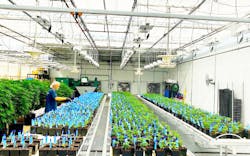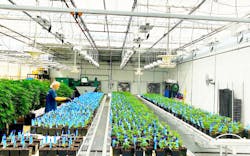Differences in securing grow facilities vs dispensaries
The cannabis industry is one of the most challenging and rewarding industries for security technology professionals to serve. Meeting regulatory requirements, and ensuring the security and safety of their people, products, facilities and reputations, all on the budget of a startup business creates both a tremendous challenge and an opportunity for creativity.
At present, cannabis is still considered a Schedule 1 Narcotic by the Federal Government under the 1970 Controlled Substance Act. Because of this designation, it makes it near impossible for these companies to receive funding from banks, credit unions and any other financial institution that is Federally insured and regulated. When funding these projects, companies within the cannabis industry are forced to rely heavily on private investors. It is crucial for security technology integrators to find creative, cost-effective ways to meet regulatory requirements, without sacrificing the safety and security of the facilities.
In addition to the challenges that the Federal law creates with funding, it also leaves the regulation of this industry up to each individual state. Understanding the expectations of each state’s regulatory body is crucial in creating a successful physical protection system. The cannabis industry desperately needs talented security technology integrators to help them strike the proper balance between compliance, safety, and cost.
While funding, regulatory compliance, and the unique threats that this industry faces all create challenges for security professionals, perhaps the biggest challenge is the diversity of the facilities used within this industry. In many instances, you’ll have the opportunity to work with companies that are vertically integrated within the industry, owning both dispensaries, where the products are sold to the public, and cultivation and processing facilities, where the plants are grown, and the products created. Each of these sites carries with them its own unique risks and challenges.Cultivation/Processing Facilities
The life cycle of the cannabis industry’s products begins at cultivation/processing facilities. It’s at these sites that the cannabis plants go all the way from seeds to the oils, pills, edibles and vapes that you find in your local dispensary. Most state regulations require the tracking of these plants with RFID technology all the way from seed to sale. That tracking begins here, using barcodes as soon as the seeds are put in the soil.
Each state requires 24/7 video surveillance and access control within these sites. Most of these facilities are large-scale indoor agricultural operations covering upwards of 100,000 square feet. The number of endpoints required to secure a space that size under normal circumstances can be massive. However, these facilities offer unique conditions that increase those requirements even further.
Many of the grow rooms now utilize vertical vegetation racking systems to maximize the yields they can produce inside the footprint of the facility. Typically, these racks extend from floor to ceiling allowing three to four different levels of shelving for plant cultivation. They are fixed on a track system that allows entire rows to be shifted from side to side to provide cultivators with access to each plant.
While this system offers tremendous flexibility and efficiency on the cultivation side, it creates an equally difficult challenge on the surveillance end. In an industry that requires every square inch of the facility to be monitored by surveillance cameras, moving shelves that extend from floor to ceiling makes meeting that regulatory requirement very challenging.
A creative solution that many of these facilities are currently using consists of installing a series of fixed dome cameras along the front and rear walls of the grow rooms. As the shelving slides and impedes the view of one of the cameras, the new corridor is covered by the camera that is positioned immediately next to it.
Another challenge posed by the plants is that it is difficult to see what individuals working around the plants are doing with their hands. Product diversion by insider threats is quite common in this industry. Even with the substantial number of cameras throughout the facility, the cover that the foliage provides can be used to remove and hide small amounts of product on the employee’s person. Over time these small amounts add up to big losses for the company. One solution that is being evaluated is the use of body-worn cameras. Like the cameras currently used by law enforcement departments across the country, these cameras can be positioned on the employee’s chest allowing everything they are doing with their hands to be monitored and recorded. Video footage can be uploaded to the security system via Wi-Fi.
While the size and scope of these facilities can be challenging to secure, they are limited access facilities. This provides security professionals with the benefit of taking an “area security” approach, where the perimeter and entry portals have a much higher level of control. Typically, the grounds are surrounded by fencing and other barriers such as bollards, controlling both vehicle and pedestrian access. Any visitors to the facility are vetted and tracked using electronic visitor management systems. For the most part, only employees, regulatory officials and company vendors will require regular access to these sites. That is not the case for dispensaries that are welcoming customers through their doors every single day.
Dispensaries
Although dispensaries are much smaller in comparison to cultivation facilities, they offer their own unique challenges. In most states, these facilities are held to the same intense regulatory standards that are present at the grow facilities. However, these sites must maintain a welcoming environment that helps turn individuals that visit their sites into life-long customers. Security measures cannot create a competitive disadvantage for these companies in the marketplace. Consumers want to feel safe when they visit these locations, but they don’t want to feel like they are entering a prison every time they shop.
Access to the facilities can be controlled up front using mantraps and video intercoms. This will allow the security staff to identify and vet the individuals before they gain access to the sales floor. From that point on, security technology can be implemented in a way that is both effective and aesthetically pleasing. Cameras can be matched to the color of the ceilings or walls to make them less noticeable. Open floor plans can allow more areas to be covered with fewer devices.
Additional precautions must be taken due to the cash-intensive nature of the industry. Because it is well known that these sites accept large amounts of cash every day, they have become frequent targets for robbery. Panic buttons should be hidden throughout the facility, including the front desk, sales floor and back-office spaces. In the event of an armed robbery, the authorities can be quietly notified using this technology.
When it comes to dispensary security, it is crucial for integrators to be heavily involved during the design phase. Collaborating with the architect, integrators can identify creative ways to blend the security equipment into the architect’s vision for the space. Partnering with architects that work in this industry can give security integrators the opportunity to get in on these projects from the very beginning and establish more credibility with these companies.
Cybersecurity is another element that needs to be considered, especially for medical cannabis facilities. These sites regularly transmit sensitive patient information over their networks. If a bad actor can exploit a vulnerability within that network to gain access to this sensitive data it can create a tremendous financial liability for the company, not to mention potentially compromise its reputation and brand. Each site should have measures in place to secure its network against phishing, ransomware and cyberextortion attacks. In addition, it is vital to provide regular cybersecurity training to company employees so they can identify attacks before they infect the network.
As the cannabis industry rapidly expands across the United States, new threats and challenges will inevitably emerge. This will create a tremendous opportunity for security professionals to serve this market. Helping guide them through the creation of a culture of security will allow their companies and the industry to safely continue its upward trajectory for many years to come.
About the Author

Ron Stein
Account Manager for Medical Cannabis and Critical Infrastructure customers at Dagostino Electronic Services, Inc.
Ron Stein is an Account Manager for Medical Cannabis and Critical Infrastructure customers at Dagostino Electronic Services, Inc., in Pittsburgh Pennsylvania. He specializes in industries and organizations that must meet high standards and regulatory compliance regarding physical and cyber security systems. He has worked with cannabis companies for six years, helping them to meet regulatory requirements and secure their facilities.


